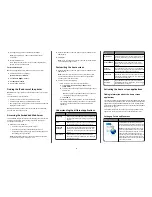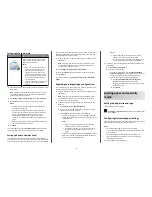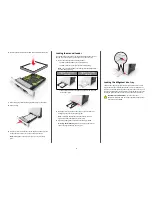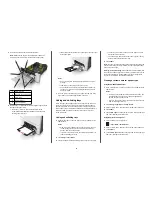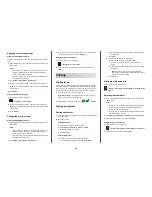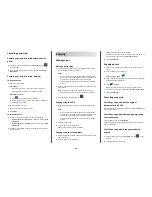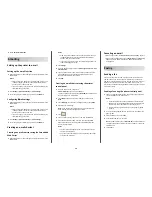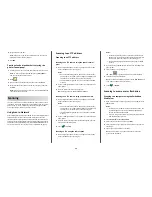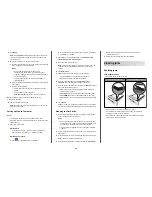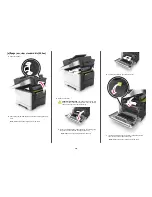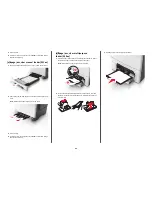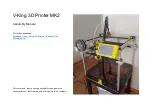
4
Assign a shortcut number.
Note:
If you enter a number that is already in use, then you are
prompted to select another number.
5
Click
Add
.
Creating a fax destination shortcut using the
printer control panel
1
From the home screen, touch
Fax
, and then enter the fax number.
Note:
To create a group of fax numbers, touch
Next number
,
and then enter the next fax number.
2
Touch
.
3
Type a unique name for the shortcut, and then touch
Done
.
4
Verify that the shortcut name and number are correct, and then
touch
OK
.
Note:
If the name or number is incorrect, then touch
Cancel
, and
then reenter the information.
Scanning
You can use the printer to send a scanned file. You can also use Scan
to Network, Multi Send, and MyShortcut applications from the printer
home screen. For more information, see the "Activating the home
screen applications" section of the
User’s Guide
.
Using Scan to Network
Scan to Network lets you scan your documents to network destinations
specified by your system support person. After the destinations
(shared network folders) have been established on the network, the
setup process for the application involves installing and configuring the
application on the appropriate printer using its Embedded Web Server.
For more information, see “Setting up Scan to Network” on page 5.
Scanning to an FTP address
Scanning to an FTP address
Scanning to an FTP address using the printer control
panel
1
Load an original document faceup, short edge first into the ADF
tray or facedown on the scanner glass.
Notes:
•
Do not load postcards, photos, small items, transparencies,
photo paper, or thin media (such as magazine clippings) into
the ADF tray. Place these items on the scanner glass.
•
The ADF indicator light comes on when the paper is loaded
properly.
2
If you are loading a document into the ADF tray, then adjust the
paper guides.
3
From the printer control panel, navigate to:
FTP
>
FTP
> type the FTP address >
Done
>
Send It
Scanning to an FTP address using a shortcut number
1
Load an original document faceup, short edge first into the ADF
tray or facedown on the scanner glass.
Notes:
•
Do not load postcards, photos, small items, transparencies,
photo paper, or thin media (such as magazine clippings) into
the ADF tray. Place these items on the scanner glass.
•
The ADF indicator light comes on when the paper is loaded
properly.
2
If you are loading a document into the ADF tray, then adjust the
paper guides.
3
From the printer control panel, press
#
on the keypad, and then
enter the FTP shortcut number.
4
Touch
>
Send It
.
Scanning an FTP using the address book
1
Load an original document faceup, short edge first into the ADF
tray or facedown on the scanner glass.
Notes:
•
Do not load postcards, photos, small items, transparencies,
photo paper, or thin media (such as magazine clippings) into
the ADF tray. Place these items on the scanner glass.
•
The ADF indicator light comes on when the paper is loaded
properly.
2
If you are loading a document into the ADF tray, then adjust the
paper guides.
3
From the home screen, navigate to:
FTP
>
FTP
>
> type the name of the recipient >
Search
4
Touch the name of the recipient.
Note:
To search for additional recipients, touch
New Search
, and
then type the name of the next recipient.
5
Touch
>
Send It
.
Scanning to a computer or flash drive
Scanning to a computer using the Embedded
Web Server
1
Open a Web browser, and then type the printer IP address in the
address field.
Notes:
•
View the printer IP address on the printer home screen. The
IP address appears as four sets of numbers separated by
periods, such as 123.123.123.123.
•
If you are using a proxy server, then temporarily disable it to
load the Web page correctly.
2
Click
Scan Profile
>
Create Scan Profile
.
3
Select your scan settings, and then click
Next
.
4
Select a location on your computer where you want to save the
scan image.
5
Type a scan name, and then a user name.
Note:
The scan name is the name that appears in the Scan
Profile list on the display.
15



